Mid-Range to High-End Buyer's Guide, January 2006
by Jarred Walton on January 2, 2006 1:00 AM EST- Posted in
- Guides
Remaining Recommendations
The majority of the remaining parts all have a lesser impact on performance, and for several areas, you can just get whatever is cheapest. A low cost case might have sharp edges inside, and a low cost PSU might be noisy or fail prematurely - particularly if you load up the system with higher end components - but otherwise, there isn't a huge difference between the remaining components other than prices. Since we're giving Mid-Range and High-End configurations, we will be spending quite a bit more on the latter for what some may feel are unimportant aspects of a computer system. The Z-5500 speakers, for example, are overkill if you're living in an apartment or small house. For that matter, even the Z-2300 speakers are more than what many users will need. More than any of the other recommendations, there is a lot of subjective opinion in picking out these remaining items. If you don't want powerful speakers, save the money. If sound quality is important - which is our assumption on the High-End platform - you will probably want good speakers as well as a discrete sound card. If you're happy with a cheap case, you can cut costs there as well. Here are our guidelines for the remaining components.
The only two areas where it's really worth upgrading to something more than the above choices are storage and the power supply. If you're planning on running multiple GPUs with multiple hard drives, the 400W SmartPower 2.0 in the Mid-Range system may prove insufficient. The ePOWER/Tagan in the High-End system is more than enough for almost any use, though there are quite a few alternatives with a similar price. Fotron Source, Antec, Enermax, Seasonic, OCZ, and several other companies make PSUs worth considering, but we like the modular design, SLI support, and general high-quality of the Tagan unit. $120 is a lot to pay for a power supply, but then we'd even take it one step further and recommend picking up a UPS to go with the computer. $100 will get a good quality UPS that will help prevent loss of data from anything ranging from a power outage to an electrical surge.
The hard drives both ended up being from Western Digital, with the only upgrade on the High-End component being the move to a 16MB cache model. 250GB of storage and 3.0Gbps transfer rates are plenty for the vast majority of users. You could even drop down to a 160GB or even 80GB HDD if you don't need the storage, though the cost per GB on the 250GB drives is the lowest of any of the models. If you store lots of music, movies, photos, etc. on your system, though, you might want to go the other way and look for more storage capacity. Seagate's 300GB and larger 7200.9 drives can be found with 16MB of cache for the ultimate in capacity and performance, but prices are quite high. Some people still swear by the faster access times of the WD Raptor drives, but personally, I would add more RAM before worrying about spending $150 for a 74GB drive. If you want some data reliability, some motherboards are even shipping with integrated RAID 5 controllers: use 3 or 4 HDDs and you can get over a TB of storage and still be protected from data loss as long as no more than one drive fails. That's really more low-end server/high-end workstation stuff, however, so we'll stick with a single 250GB drive for now.
The majority of the remaining parts all have a lesser impact on performance, and for several areas, you can just get whatever is cheapest. A low cost case might have sharp edges inside, and a low cost PSU might be noisy or fail prematurely - particularly if you load up the system with higher end components - but otherwise, there isn't a huge difference between the remaining components other than prices. Since we're giving Mid-Range and High-End configurations, we will be spending quite a bit more on the latter for what some may feel are unimportant aspects of a computer system. The Z-5500 speakers, for example, are overkill if you're living in an apartment or small house. For that matter, even the Z-2300 speakers are more than what many users will need. More than any of the other recommendations, there is a lot of subjective opinion in picking out these remaining items. If you don't want powerful speakers, save the money. If sound quality is important - which is our assumption on the High-End platform - you will probably want good speakers as well as a discrete sound card. If you're happy with a cheap case, you can cut costs there as well. Here are our guidelines for the remaining components.
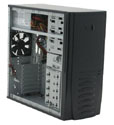 |
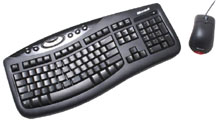 |
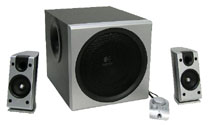 |
| Click images to enlarge. | ||
| Mid-Range Components | ||
| Hard Drive | Western Digital 3.0Gbps 250GB 7200RPM 8MB Caviar SE | 99 |
| Optical Drive | BenQ DVDR DQ60 (OEM) | 41 |
| Case and Power Supply | Antec Solution SLK3800B + 400W SmartPower 2.0 | 116 |
| Speakers | Logitech Z-2300 2.1 | 112 |
| Keyboard and Mouse | Microsoft Comfort Curve 2000 + Optical Mouse | 30 |
| Total | 398 | |
 |
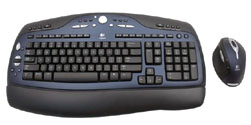 |
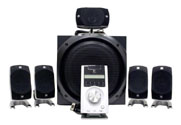 |
| Click images to enlarge. | ||
| High-End Components | ||
| Hard Drive | Western Digital 3.0Gbps 250GB 7200RPM 16MB Caviar SE16 | 115 |
| Optical Drive | NEC DVDR ND-3550A | 43 |
| Case | Lian Li PC-6077B Aluminum | 138 |
| Power Supply | ePOWER/Tagan TG-530-U15 530W | 120 |
| Sound Card | Creative Sound Blaster Audigy 2 ZS | 73 |
| Speakers | Logitech Z-5500 5.1 w/Dolby Digital | 253 |
| Keyboard and Mouse | Logitech Cordless Desktop MX3100 (Laser tracking mouse) | 95 |
| Total | 837 | |
The only two areas where it's really worth upgrading to something more than the above choices are storage and the power supply. If you're planning on running multiple GPUs with multiple hard drives, the 400W SmartPower 2.0 in the Mid-Range system may prove insufficient. The ePOWER/Tagan in the High-End system is more than enough for almost any use, though there are quite a few alternatives with a similar price. Fotron Source, Antec, Enermax, Seasonic, OCZ, and several other companies make PSUs worth considering, but we like the modular design, SLI support, and general high-quality of the Tagan unit. $120 is a lot to pay for a power supply, but then we'd even take it one step further and recommend picking up a UPS to go with the computer. $100 will get a good quality UPS that will help prevent loss of data from anything ranging from a power outage to an electrical surge.
The hard drives both ended up being from Western Digital, with the only upgrade on the High-End component being the move to a 16MB cache model. 250GB of storage and 3.0Gbps transfer rates are plenty for the vast majority of users. You could even drop down to a 160GB or even 80GB HDD if you don't need the storage, though the cost per GB on the 250GB drives is the lowest of any of the models. If you store lots of music, movies, photos, etc. on your system, though, you might want to go the other way and look for more storage capacity. Seagate's 300GB and larger 7200.9 drives can be found with 16MB of cache for the ultimate in capacity and performance, but prices are quite high. Some people still swear by the faster access times of the WD Raptor drives, but personally, I would add more RAM before worrying about spending $150 for a 74GB drive. If you want some data reliability, some motherboards are even shipping with integrated RAID 5 controllers: use 3 or 4 HDDs and you can get over a TB of storage and still be protected from data loss as long as no more than one drive fails. That's really more low-end server/high-end workstation stuff, however, so we'll stick with a single 250GB drive for now.










67 Comments
View All Comments
tjpark1111 - Tuesday, January 3, 2006 - link
never mind my post above I just read a recommendation for a 19" widescreen above and I am pleased now. However, I have a laptop with a widescreen too and there are still black bars on dvds and the top and bottom, but the bars are only like a quarter of an inch or so. I read some reviews for widescreen LCDs and it seems all of widescreen LCDs, at least computer LCDs are 16:10. What is the reason for that, because a very large part of widescreen, is watching widescreen movies in their native format and what's the point if there's still black bars on the screen? Is there a video-playing app that'll remove those bars or something? thank you. also, any comment on that viewsonic widescreen 19"? user reviews?Anton74 - Tuesday, January 3, 2006 - link
I'm not sure about the 16:10 ratio, but the reason you'll often keep seeing black bars watching movies is that there are several aspect ratios that are wider even than 16:9 which are commonly used (for movies). You should find it on the back of the DVD cover; there's 1.85:1 and 2.35:1 for example, and especially the latter is wider than 16:9 (which is ~1.78:1).The thing that bugs me about all this is that they see fit to modify movies to 4:3 for some DVDs, VHS, and network/cable broadcast, but I've never seen a movie modified to fit 16:9, which to me seems the logical thing to do (at least as an option). When (finally) I buy HD equipment, I'm going to make sure that either the TV or the DVD player can zoom to make these wider-screen formats fit 16:9 (without destroying the aspect ratio, thankyouverymuch).
tjpark1111 - Thursday, January 5, 2006 - link
nope not at all, it says it's 16:10 on the Viewsonic Website. As I understand it, with the help from the fellows of AVSForum and Videohelp, it seems most dvds are encoded in 16:9 native. Now some DVDs, are encoded into aspect ratios such as those that you mentioned. The Matrix Series is a common DVD to test response times and dark scene performance, and that DVD is certainly not encoded in 1:85:1 or 2:35:1, and there still are black bars. 16:10 will therefore leave black bars on ANY DVD or HD Material unless there is some app from viewsonic that will stretch all video content. Stretching for this case will not look bad at all since it is such a small stretch. I find this whole thing to be VERY stupid because again, widescreen in the first place was largely from theatres being widescreen, so consumer display devices tried to copy that widescreen format, with movies following along.dlerious - Monday, January 2, 2006 - link
That Benq DQ60 has to be the worst burner out there right now. I'd put anything but that ine on the list.JarredWalton - Tuesday, January 3, 2006 - link
Hm. I bought a few of them last month. I haven't had any serious problems, but then I don't really think too much about my optical drives anymore. I've got Imation 8X DVD+R discs that work fine when I need them.Anton74 - Monday, January 2, 2006 - link
Jarred - am I correct in assuming from your description of the Acer 19" panel that you guys have not actually laid eyes on it?I'm trying to find out some more info on this, but the Acer web site doesn't seem to be all that helpful. While I can find several AL1914 models, I don't see an AL1914smd (the closest thing I see is the AL1914s-8). I can't gather from their descriptions or specifications whether these are 6 or 8 bit panels.
Great article otherwise, and I agree with your thoughts on SLI and getting a good monitor (although, for many non-office uses I'd personally rather stick with a good CRT, provided the desk space is available).
JarredWalton - Tuesday, January 3, 2006 - link
I'll take a decent LCD over a similar CRT for most tasks, but there's personal preference. 21/22" CRTs are just so HUGE (in depth), plus they weigh a ton. Anyway, I purchased three of the 1914smd from Newegg about 5 months ago, and they all worked well. I couldn't spot any dithering, but then my eyes aren't the greatest. (Irregular astigmatism = noncorrectable = sucky double vision.) I got them http://www.newegg.com/Product/Product.asp?Item=N82...">at Newegg for $350, and the same displays are now under $300.My one gripe with LCDs is the refresh rate. 60 Hz or 75 Hz means that you do see tearing in 3D games - unless you enable vsynch. A nice CRT with a 100 Hz refresh rate doesn't usually show that problem.
Anton74 - Tuesday, January 3, 2006 - link
Thanks much, this is useful info. I also saw the 1914smd on newegg, and was considering one of these among others (...for non-gaming office use :).JarredWalton - Tuesday, January 3, 2006 - link
I put four systems with those in a dental office. If you want to do wall mounts, there are probably better choices, but they were primarily for the desk and a couple mounted on clamps so the patients could watch videos or whatever. :)abravo01 - Monday, March 20, 2006 - link
Hi there.Great guide, as usual: still my key source for system upgrade/renovation.
I am based in Portugal and this model is not yet on the market. What would be your thoughts about these two Acer displays: AL1951AS and AL1951Cs? Acer is selling them as "gaming line"... whatever that means... price wise it's pretty much the same.
One other question: for working and gaming would you say that WS is worth the premium?
Thanks.
André.